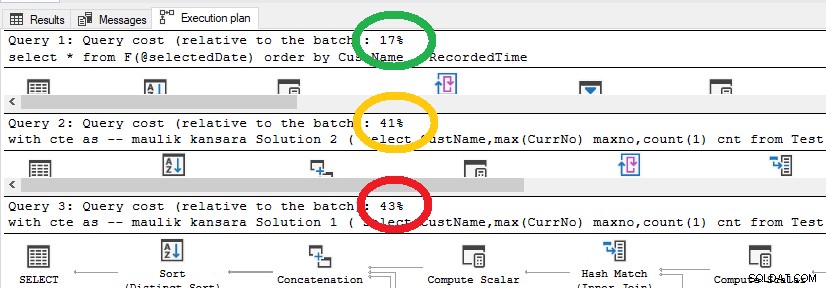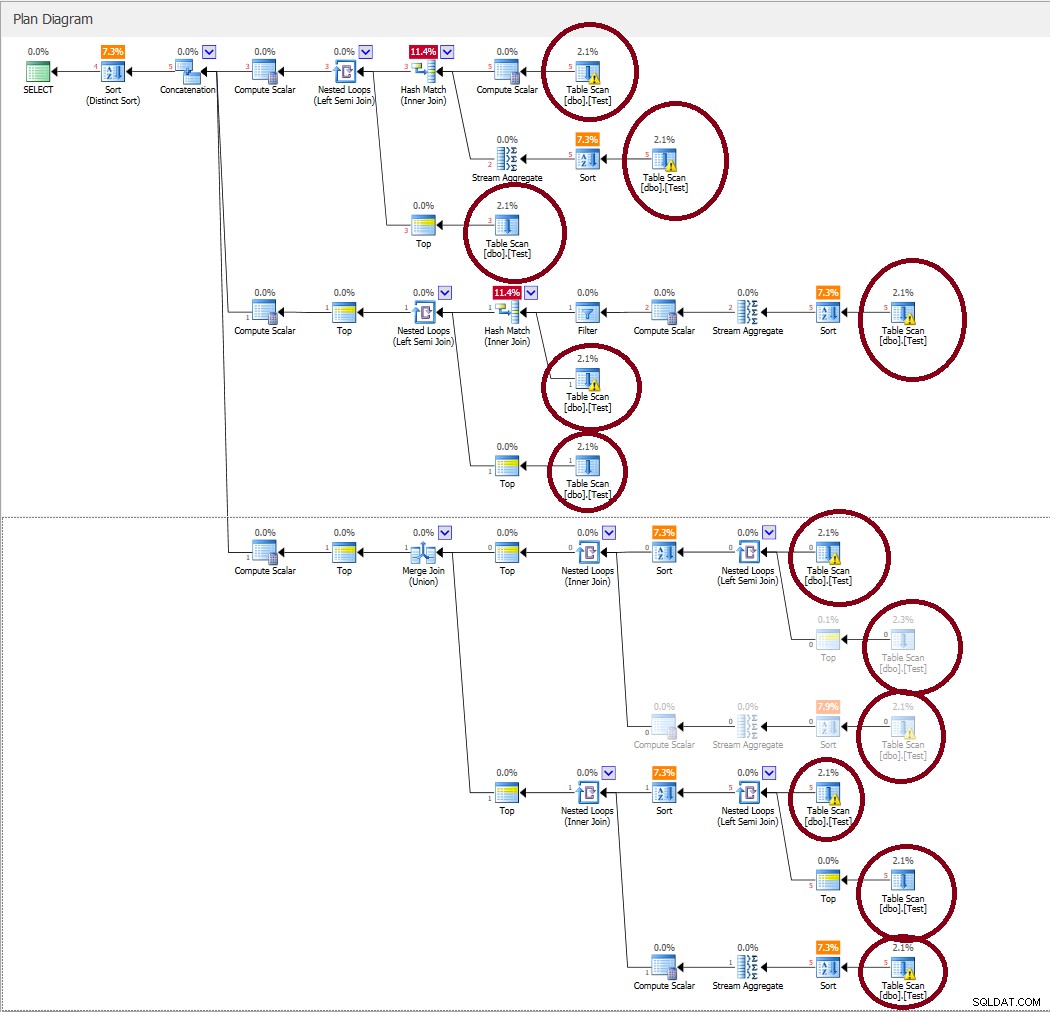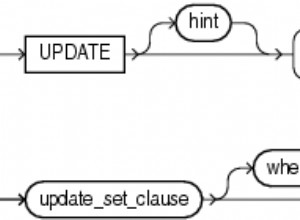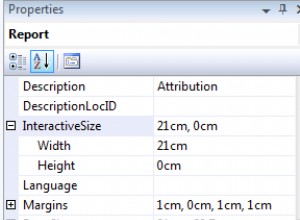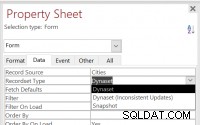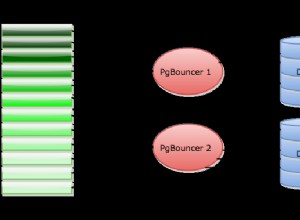Bonne journée,
Veuillez vérifier si la solution ci-dessous répond à tous vos besoins. Je l'ai testé avec vos données et avec quelques lignes supplémentaires, mais il est toujours préférable de revérifier. À première vue, il semble qu'il renvoie le résultat demandé. J'ajouterai quelques explications plus tard
La requête que je l'utilise ceci :
DECLARE @Date DATE = '2018-06-12';
with MyCTE as (
SELECT
t.CustName,t.Country,t.RecordedTime,t.CurrNo, D = CONVERT(DATE, RecordedTime)
,RN_D = ROW_NUMBER()
OVER (partition by t.CustName order by t.CurrNo desc)
,RN = ROW_NUMBER()
OVER (partition by t.CustName order by t.CurrNo)
,RN_Old = ROW_NUMBER()
OVER (partition by t.CustName, (CASE WHEN CONVERT(DATE, RecordedTime) < @Date then 0 else 1 END) order by t.CurrNo desc)
,Cnt = COUNT(*)
OVER (partition by t.CustName)
,CntToday = COUNT(CASE WHEN CONVERT(DATE, RecordedTime) = @Date THEN 1 ELSE NULL END)
OVER (partition by t.CustName)
FROM Test t
where
-- returns rows untill current date
CONVERT (DATE, RecordedTime) <= @Date
-- only if relevnat to current date
and EXISTS (
SELECT * FROM test t0
where CONVERT (DATE, RecordedTime) = @Date and t0.CustName = t.CustName
)
)
,MyCTE2 as (
select
CustName, Country, RecordedTime, D, CurrNo, RN_D, RN, Cnt, t2.c, History, CntToday, RN_Old
from MyCTE t1
left JOIN (select * from (values(1, 'NEW'),(1, 'BEFORE')) t2(c, History) ) t2
on t1.CurrNo = t2.c
and CntToday > 1
and D = @Date
where
RN_D = 1
or (RN = 1 and D = @Date)
or (RN_Old = 1 and D < @Date)
)
,MyCTE3 as (
select CustName, Country, RecordedTime
-- unmarke the bellow comment in order to get the accessories columns I used
-- This is recommended to understand the line-of-thinking
--, D, c, RN_D, RN, CurrNo, Cnt, CntToday, RN_Old
, History = CASE
WHEN CurrNo = 1 and Cnt = 1 then 'NEW'
WHEN RN_D = 1 then 'CURRENT'
else ISNULL(History,'BEFORE')
END
from MyCTE2
)
select CustName, Country, RecordedTime--, D, c, RN_D, RN, CurrNo, Cnt, CntToday, RN_Old
,Audit = CASE when History='New' then 'ADD' else 'CHANGE' END
, History
from MyCTE3
Pour simplifier le test, j'insère la requête entière dans la fonction de table
DROP FUNCTION IF EXISTS dbo.F
GO
CREATE FUNCTION dbo.F(@Date DATE)
RETURNS TABLE AS RETURN (
--DECLARE @Date DATE = '2018-06-12';
with MyCTE as (
SELECT
t.CustName,t.Country,t.RecordedTime,t.CurrNo, D = CONVERT(DATE, RecordedTime)
,RN_D = ROW_NUMBER()
OVER (partition by t.CustName order by t.CurrNo desc)
,RN = ROW_NUMBER()
OVER (partition by t.CustName order by t.CurrNo)
,RN_Old = ROW_NUMBER()
OVER (partition by t.CustName, (CASE WHEN CONVERT(DATE, RecordedTime) < @Date then 0 else 1 END) order by t.CurrNo desc)
,Cnt = COUNT(*)
OVER (partition by t.CustName)
,CntToday = COUNT(CASE WHEN CONVERT(DATE, RecordedTime) = @Date THEN 1 ELSE NULL END)
OVER (partition by t.CustName)
FROM Test t
where
-- returns rows untill current date
CONVERT (DATE, RecordedTime) <= @Date
-- only if relevnat to current date
and EXISTS (
SELECT * FROM test t0
where CONVERT (DATE, RecordedTime) = @Date and t0.CustName = t.CustName
)
)
,MyCTE2 as (
select
CustName, Country, RecordedTime, D, CurrNo, RN_D, RN, Cnt, t2.c, History, CntToday, RN_Old
from MyCTE t1
left JOIN (select * from (values(1, 'NEW'),(1, 'BEFORE')) t2(c, History) ) t2
on t1.CurrNo = t2.c
and CntToday > 1
and D = @Date
where
RN_D = 1
or (RN = 1 and D = @Date)
or (RN_Old = 1 and D < @Date)
)
,MyCTE3 as (
select CustName, Country, RecordedTime
-- unmarke the bellow comment in order to get the accessories columns I used
-- This is recommended to understand the line-of-thinking
--, D, c, RN_D, RN, CurrNo, Cnt, CntToday, RN_Old
, History = CASE
WHEN CurrNo = 1 and Cnt = 1 then 'NEW'
WHEN RN_D = 1 then 'CURRENT'
else ISNULL(History,'BEFORE')
END
from MyCTE2
)
select CustName, Country, RecordedTime--, D, c, RN_D, RN, CurrNo, Cnt, CntToday, RN_Old
,Audit = CASE when History='New' then 'ADD' else 'CHANGE' END
, History
from MyCTE3
--order by CustName, RecordedTime
)
GO
En utilisant la fonction, il est plus simple de faire plusieurs tests, mais probablement dans la production, vous voudrez utiliser la requête directe
-- Test
select * from F('2018-06-01') order by CustName , RecordedTime
select * from F('2018-06-02') order by CustName , RecordedTime
select * from F('2018-06-03') order by CustName , RecordedTime
select * from F('2018-06-10') order by CustName , RecordedTime
select * from F('2018-06-11') order by CustName , RecordedTime
select * from F('2018-06-12') order by CustName , RecordedTime
select * from F('2018-06-13') order by CustName , RecordedTime
select * from F('2018-06-14') order by CustName , RecordedTime
/**************** Mise à jour au 2018-08-19 14:05 heure d'Israël ****************/
Je remarque qu'il est important d'ajouter quelques informations supplémentaires pour participer au fil de discussion. J'espère que cela vous sera utile
Tout d'abord, comparons le pourcentage d'utilisation des ressources en fonction des plans d'exécution de trois requêtes :(1) ma solution, (2) maulik kansara seconde solution après la mise à jour de la première solution et (3) maulik kansara première solution
Vérifions maintenant l'image de l'EP de maulik kansara seconds solution :
Cette requête parcourt la table 11 fois !

